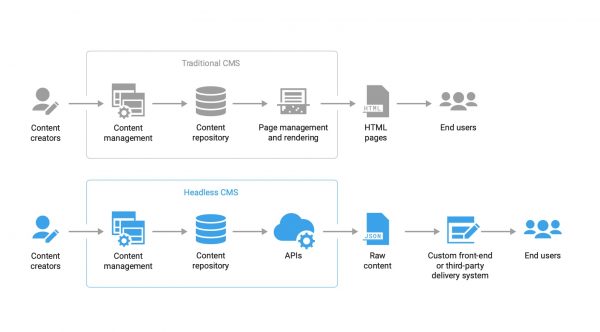Next-Generation CMS: Why Advanced Content Management is the Key to Sustained Growth and Profitability

How is content management evolving, and how can your enterprise ensure it is ahead of the curve? Learn how to harness the next generations of content management systems.
Content management systems (CMSs) have been around for decades. As platforms and environments to enable businesses to create, manage and distribute their content, they have formed the bedrock of customer communications.
Indeed, since the advent of the Internet, the CMS has become an invaluable tool for creating a myriad of online content. But what does the future hold? Are the current CMS tools still fit for purpose, and how should businesses evolve their CMS to the next level?
Yann Gautier, general manager of managed services at global digital consultancy Appnovation commented to Silicon UK: “The fact that headless CMS is a decoupled system means that, when it comes to orchestration of content and reusability, it offers key advantages over traditional tightly coupled and monolithic solutions. Headless CMS is lightweight in nature and can execute solution engineering at speed. Consequently, when it comes to tactical and rapid digital projects, many enterprises are adopting a strategy of deploying a headless CMS in parallel to their existing DXP (Digital Experience Platform).”

The shift to headless CMS directly reacts to businesses’ importance on customer experiences (CX). In their report, Magnolia state: “When developing these great customer experiences, the right content management technology is vital. Businesses must choose technologies that help bundle data, distribute content, and deliver services across an ever-wider variety of customer touchpoints. At the same time, customer expectations are rising, with today’s enterprises being expected to deliver high quality, personalised content, quickly and at scale.”

The issue is that the volume of content that businesses now produce has mushroomed. Manually updating and deploying what could be thousands of pieces of content across an increasing and diverse range of platforms and devices means something must change. And for IT teams, migrating to a more flexible approach to CMS management and deployment can deliver significant cost and efficiency savings.
Headless CMS platforms also enable other business areas to benefit – most notably marketing which can use headless CMS tools to create engaging content for highly defined audiences. However, marketers often lack an intuitive and visual user interface that they may be familiar with traditional CMS systems and can be lacking with today’s headless platforms.
“An immediate benefit of headless websites is dramatically increased performance – the speed of loading a page, and the scale of handling a burst of traffic often at less cost,” commented Jason Cohen, founder and CTO of WP Engine. “Architecturally, headless also more easily supports multiple front ends, so for example a website on React and a mobile app with React Native, all sharing the same content, same algorithms, and even the same user interface components. Separating the content from the rendering enables agencies who want to save costs over time to share resources.”

However, as Sonja Keerl, global head of product marketing, Contentstack, and current president of the MACH Alliance, also warns: “Headless alone is not an efficient answer. To create efficient, automated processes, a business needs to embrace cloud-native SaaS alongside the headless API. Once these composable architectures are in place, a business can outpace the competition by about 80% (as per Gartner figures). Our experience has been that business teams can accelerate by 2-5 times and IT / dev teams by 2-10 times, based on the frequency of the ideas coming out. For example, The Spectator used Contentstack’s headless CMS, improving publishing time by 20% and in some cases, what used to take days now only takes hours.”

Going headless
The research carried out by Storyblok concluded that over a third of respondents find their CMS time consuming to use, with nearly 20% also stating that the lack of support for developers that need to make bespoke changes to their CMS is also a challenge.
Listen to a Silicon UK audio interview with Dominik Angerer, CEO and Co-founder of Storyblok, here.
Respondents were asked to rate their current workflow satisfaction where the majority of users noted their existing workflow as fair to moderate (46%), followed by an easy rating (30%) and finally complex (13%) as the top three satisfaction marks.
In this context, headless CMS has been gaining ground over recent years as it can resolve many of the issues businesses currently face when developing new content across their enterprises. Also, switching to headless CMS can save time – a constant challenge for all enterprises when quizzed about the pain points of their current CMS.
To gain an insight into how headless CMS is developing and what this means for business leaders, Silicon UK spoke with Josh Koenig, Co-founder and CSO, Pantheon.

Why is traditional CMS failing businesses?
“Traditional Enterprise CMSs never really made the transition to the cloud. Even if you can deploy them on AWS, Azure, or Google, they’re still managed mainly in the traditional model of Enterprise IT software. As a result, they are all too often the slowest-moving component in any digital transformation effort, creating a constant source of tension between Marketing and IT.
“Furthermore, the traditional model is monolithic: “one installation of the CMS to rule them all” means that this single instance of software has to be all things to all stakeholders and often becomes so over-complicated in their implementation that specialist roles are required to update the copy on a page and to adjust the design or user-experience is effectively impossible outside of a major overhaul.
“Compounding the challenge of complexity, the scarcity of talent that can work creatively with these legacy technologies contributes to the maddeningly slow rate of change. As a result, many leaders frankly just give up on their website, start slapping on more overlays and pop-ups as a short-term fix, and bide their time for the subsequent relaunch cycle to try and make any fundamental progress.
“But this traditional cycle of “relaunching” every few years simply cannot hope to keep up with the pace of change in the market. Customers demand better. With the web becoming a primary channel for every business, something must change.
Businesses are continually looking for efficiency gains, but can headless CMS deliver tangible advantages?
“A headless CMS allows for a separation of concerns between content management and content display. While this is often positioned aspirationally around multi-channel content — it’s on the web, the phone, and your fridge! — the most common immediate practical benefit is that it frees up an organisation to modernise its experience layer much more quickly than it could in a traditional monolithic setup.
“While implementing a new experience with tools like Adobe Experience Manager or SiteCore requires an effective project plan and expertise that really only exists within a handful of large consultancies and systems integrators, rolling out a new multi-page experience built with a modern frontend (JAMStack style) is truly agile. A minimum viable product can be up and running in a matter of weeks and then safely and effectively evolved and iterated upon, with talent drawn from over a million generalist web developers.
“That said, the process of breaking traditional monolithic CMSs down creates significant operational complexity. While frontend developers can move much faster, they will need to invest in workflow and coordination to avoid breaking things. Likewise, the brave new world of headless CMS and modern frontends leaves a lot of “built-in” functionality of the old monolithic world, such as the ability to preview content, publish in real-time, handle form submissions, or perform “out of the box” SEO, by the wayside.
“Organisations that try to go headless without accounting for these implementation costs and ongoing operational overhead often end up doing an about-face and “re-coupling” a few years later. It’s important to fully account for use-cases and stakeholders when evaluating an architectural change as a solution. You need to consider people, process, and technology.”
Is a hybrid approach often the first step businesses take before full headless CMS is embraced?
“The metaphor of “headless” is pretty bad for most organisations thinking about this topic. I take some accountability for promoting this language, going back to a San Francisco Drupal Users Group MeetUp in 2014 and including several conference presentations, and I apologise to everyone. However, the reality is it’s always some kind of hybrid and likely always will be.
“Conceptualising this architectural evolution as a binary switch will lead to a project with massive scope as you start to plan for how to fix everything all at once. But unfortunately, this is just another “relaunch” and is almost certainly doomed to fail.
“Instead of trying to plan through all the complexity, the important thing is to invest in the people, processes, and platforms that promote agility. Creating a prioritised list of functions or experiences and figuring out how to de-risk them and deliver smaller wins more quickly is the name of the game. That requires a hybrid strategy, but I’d argue that there’s not much value in trying to plan towards some end state of “full headless” and more value in figuring out how to effectively operate in a more agile fashion.
Has the pandemic (and the massive expansion of online retail) shifted the focus towards headless CMS?
“I think that’s confusing the cart and horse. The pandemic and attendant changes in customer behaviour (not just in retail, but all sectors from B2B to education and even government) created massive incentives to improve the quality of the web as a channel for engaging customers, prospects, fans, followers, or just the public in general.
“The imperative to improve the quality of the user experience drove the adoption of headless as a downstream consequence of two things:
- We need to modernise the user experience layer technology by adopting modern web frontend tools and design processes.
- We need to move faster organisationally and bring more real business functionality (including, but not limited to, e-commerce) directly into the web channel.
“The twin drivers for better UX that can include more real functionality and evolve faster as things change basically forced a lot of organisations to declare bankruptcy in terms of the amount of technical (and content) debt that had piled up in their legacy CMS.”
Why is headless CMS an efficient and flexible environment to deliver enhanced customer experiences?
“Headless CMS facilitates the use of modern tooling for web-based experiences. The same toolchain that powers full application experiences (everything from Office 365 to Slack to Spotify) can now power any website. This is technically possible without going headless, but the truth is leveraging a modern Javascript toolchain inside a legacy CMS is a massive pain, and almost never results in the kind of velocity that can be achieved by letting the frontend devs run their own workstream.”
What IT infrastructure does a business need to start using headless CMS?
“The main thing for IT to understand is that the headless CMS itself is only part of the equation. Whether you pick a SaaS tool or invest in Open Source to maintain more control over your data model and costs, the headless CMS alone delivers absolutely no business value.
“Adopting this approach requires having the platforms, processes, and people necessary to deliver the user interfaces that consume content from the CMS as an API. In addition, it’s crucial to have the capability to manage workflows across multiple layers of software and automate as much as possible.
“For organisations that have not yet profoundly embraced DevOps, they should consider that a prerequisite investment. Those that already have automation and tooling in place for CI/CD will need to plan for that to support fully independent frontend deployment pipelines and in the API management required to monitor, manage, and troubleshoot any issues in communication between front and back-ends.
“Finally, don’t forget about the users of the CMS itself. Not all headless CMSs are very user-friendly out of the box and often lack built-in administrative functions your teams may have taken for granted.
“If you sever the frontend, but don’t change the dynamic of a system that requires specialised operators you’ll likely find yourself stuck soon. A common anti-pattern in failed attempts to decouple is that non-developers (for example, marketing team members) aren’t able to use the CMS themselves, or face a significant loss of functionality as a result of the new tooling. This can lead to project failure, so be sure you take into account their needs and scope appropriately.”
How can headless CMS integrate with other business processes?
“The headless CMS itself usually includes the ability to pull data in via API and syndicate content out. This can act as a lightweight middleware or “mash-up” layer. However, be mindful of making the CMS a record system for non-content data.
“Also, modern frontends that power user interfaces on top of headless can be good points of integration. It’s not uncommon to see one front end which leverages more than one back-end to deliver the right digital experience; for example, one website that includes content, social, and commerce functionality.”
Is the future of CMS headless?
“Headless as a movement is really about enabling machine-readable content for more modern use-cases, delivering data via APIs instead of static pages for human eyeballs. Legacy CMSs have already done that in RSS, microformats, and advanced SEO. They almost all include some dynamic AJAX functionality that’s technically headless. So, it’d argue that headless is already the present.
“What’s the future of CMS is two things:
- A modern web UI/UX toolchain that’s powerful enough to deliver native quality application experiences.
- The operational sophistication (DevOps) treats CMSs and the rest of the web channel like modern SaaS software instead of annual marketing campaigns.
“This is making the line between “site” and “app” increasingly blurry on the web, changing the way native applications are built and delivered, and increasingly driving a more interconnected experience via connected devices, augmented reality, etc.
“Organisations that want to thrive in the next era of CMS technology need to invest in applying the principles of DevOps to all aspects of delivering the user experience. The web is a central touchpoint for almost every kind of engagement; actions are clicks, and clicks go to URLs, and URLs are on the web, so the ability to turn that channel from one that’s frozen in time between bi-annual overhauls is essential. That’s why more and more organisations are planning to adopt WebOps and bring the mindset of modern software engineering to the challenges of the web itself.”
“With CX now firmly driving all aspects of business, embracing the benefits of headless CMS could be a massive opportunity for some enterprises. However, headless CMS won’t be the solution for every company. As with any new technology deployment, performing due diligence will reveal whether headless CMS could be revolutionary, evolutionary or a technology that isn’t currently needed.”